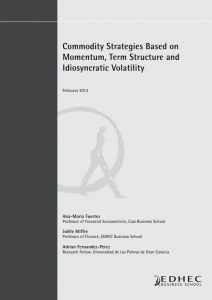

Commodity Strategies Based on Momentum, Term Structure and Idiosyncratic Volatility
This article demonstrates that momentum, term structure and idiosyncratic volatility signals in commodity futures markets are not overlapping, which motivates the design of a new triple-screen strategy. Over the period between January 1985 and August 2011, systematically buying contracts with high past performance, high roll-yield and low idiosyncratic volatility, while shorting contracts with poor past performance, low roll-yields and high idiosyncratic volatility generates an average Sharpe ratio that is five times that of the S&P-GSCI. The triple-screen strategy dominates each of the individual strategies and its risk-adjusted performance cannot be attributed to overreaction, liquidity risk or neglecting transaction costs.
Author(s):
Summary:
This article demonstrates that momentum, term structure and idiosyncratic volatility signals in commodity futures markets are not overlapping, which motivates the design of a new triple-screen strategy. Over the period between January 1985 and August 2011, systematically buying contracts with high past performance, high roll-yield and low idiosyncratic volatility, while shorting contracts with poor past performance, low roll-yields and high idiosyncratic volatility generates an average Sharpe ratio that is five times that of the S&P-GSCI. The triple-screen strategy dominates each of the individual strategies and its risk-adjusted performance cannot be attributed to overreaction, liquidity risk or neglecting transaction costs.
Register to download PDF
Register/Log in| Type : | Working paper |
|---|---|
| Date : | 02/11/2013 |
| Keywords : |
Commodities |

